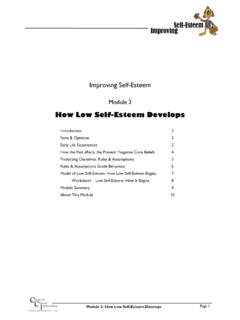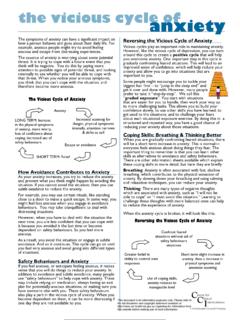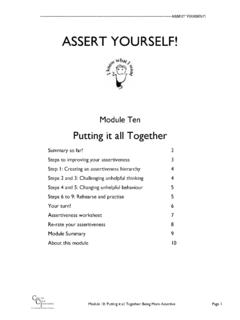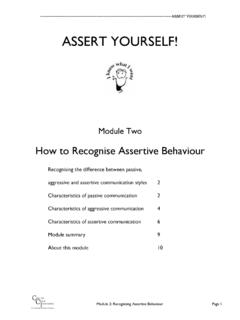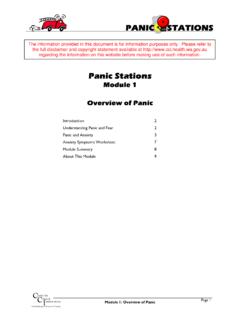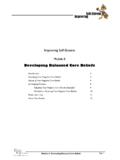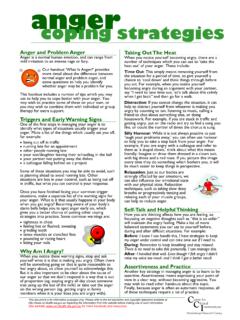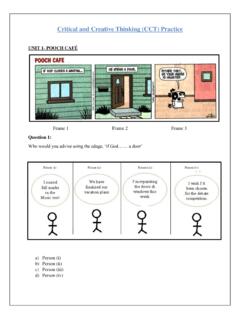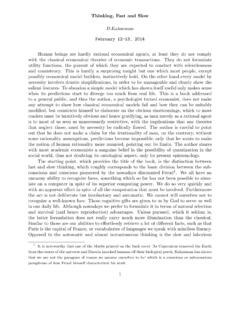Transcription of Self-Compassionate Thinking
1 Building Self-Compassion Building Self-Compassion Module 5 Self-Compassionate Thinking Introduction 2 The Thought-Feeling Connection 2 Compassionate Thought Diaries 3 Compassionate Thought Diary (Example) 6 Worksheet: Compassionate Thought Diary 7 Compassionate Letter Writing 8 Appreciating the Positives 10 Module Summary About the Modules 11 12 Building Self-Compassion The information provided in the document is for information purposes only. Please refer to the full disclaimer and copyright statements available at regarding the information on this website before making use of such information. Page 1 Psychotherapy Research Training C C I entre for linical nterventions Module 5: Self-Compassionate Thinking Building Self-Compassion Introduction Ideally you have been practicing your compassionate image, and when you slow your breathing down and bring this image to mind you notice it triggers a shift in how you are feeling.
2 You may notice some warmth within, and feelings of calm, kindness and strength start to arise. So, now what? Essentially by using your breathing and compassionate image you can shift gears and activate the soothe system and calm the threat system whenever you need to. We now want to take this a step further, and deliberately allow these compassionate feelings to influence the way you think about any difficult situation you find yourself in. This module will take you through two ways that you can do this ( , Compassionate Thought Diaries and Compassionate Letter Writing), showing you how to purposely bring a compassionate perspective or mindset to any specific struggle you face. We will also finish this module by considering how you can train your attention in a manner that is a bit different to what you have already done in Module 3.
3 That is, how you can train your attention to generally appreciate the positives in life. This can be a nice counterbalance to the threat system that is always on the lookout for the negatives, and hence might help us to spend more time in soothe mode. The Thought-Feeling Connection What you think, and the thoughts that go through your mind, are very important in determining how you feel. Stop for a moment and think: when you are feeling good, what sorts of thoughts roam around in your head? Conversely, when you are feeling bad, what sorts of thoughts are you having? It makes sense to most people when we say that: It is not the situation you are in that determines how you feel, but the thoughts, meanings, and interpretations you bring to that situation.
4 Here is an example of what we mean. Imagine you are told that you will have a pop quiz on Monday. Below are three different ways of Thinking about this same situation and the different emotions, behaviours, and physical sensations that would result from Thinking in these different ways. Example event: Being told I have a pop quiz Emotions Behaviour Physical Thought 1 I love quizzes! I know this stuff quite well so I think I ll do fine. Happy Do a bit of revision Quite relaxed Thought 2 I am useless at quizzes. I am such an idiot. I don t know anything, I am going to fail for sure. Anxious Sad Try to study hard, but can t concentrate, give up, don t get much done Sick in stomach Tense Thought 3 So what?
5 I don t care. This subject isn t important anyway. Neutral Do no study Quite relaxed Page 2 Psychotherapy Research Training C C I entre for linical nterventions Module 5: Self-Compassionate Thinking Building Self-Compassion Can you see how what we think can be so important in determining how we feel emotionally and physically, and can influence what we do? We have already discussed in Module 1 how self-critical Thinking about any situation can leave us feeling a variety of uncomfortable emotions like anxiety, sadness, depression, guilt, shame or anger. Thought 2 ( I am useless at quizzes. I am such an idiot. I don t know anything, I am going to fail for sure ) is an example of what self-criticism can do to us, showing how it generates difficult emotions, and can lead to unhelpful behaviours and uncomfortable physical sensations too.
6 As we have said previously, with self-critical Thinking , our internal self-talk is highly negative, disparaging and berating. The content of self-critical thoughts can be very cruel, but also the tone of our internal voice when we speak to ourselves is usually very cold, harsh, and attacking. Now remembering the idea that how we think largely determines how we feel, then one way to lift uncomfortable emotions is to change the way we are Thinking . This means that you don t just accept your self-critical thoughts as true, but instead use your breathing and compassionate image to shift your mindset into self-compassion gear. Once you are in this more helpful gear, start to question the way you are Thinking and see if you can t bring a more compassionate perspective to the situation.
7 Doing this can then have a positive impact on how you are feeling. Compassionate Thought Diaries We would like to introduce you to a Compassionate Thought Diary to guide you in developing more Self-Compassionate ways of Thinking . If this way of Thinking is new to you, then following a step-by- step guide can be useful. Even if you are familiar with this approach, putting pen to paper can free your mind, making it less cluttered so you are able to think more clearly and compassionately. On page 6 is an example of how to complete a thought diary, and following that is a blank copy for you to practice on. The diary guides you through how to put your self-critical thoughts out on paper, and how to bring a more compassionate perspective to whatever you are dealing with.
8 The diary will first ask you to write down information about your Self-Critical Thinking . For example: What is the trigger? The trigger can be a specific situation you are experiencing, or just Thinking about something like a memory of the past or Thinking about something in the future, or it could be a current emotion or physical sensation you are experiencing. The trigger is whatever you are struggling with. What is the self-critical part of me saying? This is where you list all the unhelpful or negative thoughts that might be running through your mind about the trigger. A number of these are likely to be unkind thoughts directed towards yourself. What tone of voice is it using? This acknowledges that it isn t just what we say to ourselves that can be hurtful, but the way we say it.
9 The tone of our internal voice is important to recognise, because it has an effect on how we feel. How much do I believe the self-critical thoughts? Rate the strength of your belief between 0 and 100%. That is, how convincing the self-critical thoughts seem to you. Page 3 Psychotherapy Research Training C C I entre for linical nterventions Module 5: Self-Compassionate Thinking Building Self-Compassion What emotion(s) am I feeling? And rate the intensity of the main emotion you are experiencing, between 0 and 100%. What physical sensations or behaviours go with these feelings? This recognises that our thoughts don t just affect our emotions, but our physical feelings and what we do too.
10 This section of the diary will just help you to become more aware of how you are Thinking and feeling. At this point nothing changes, we just have more clarity about what is going on for us, and hence are in a better position to meet this struggle with some self-compassion. The next part of the diary will be about shifting perspective and injecting some Compassionate Thinking into the mix. To do this, you must first call upon your slow Breathing and Compassionate Image. Once doing this has helped to activate the soothe system and calm the threat system, you will be in a much better frame of mind to bring a compassionate perspective to whatever you are dealing with. There are a number of questions listed in the diary to help you entertain more compassionate Thinking .
